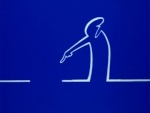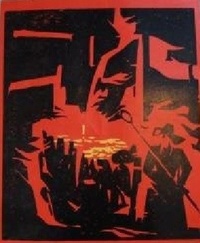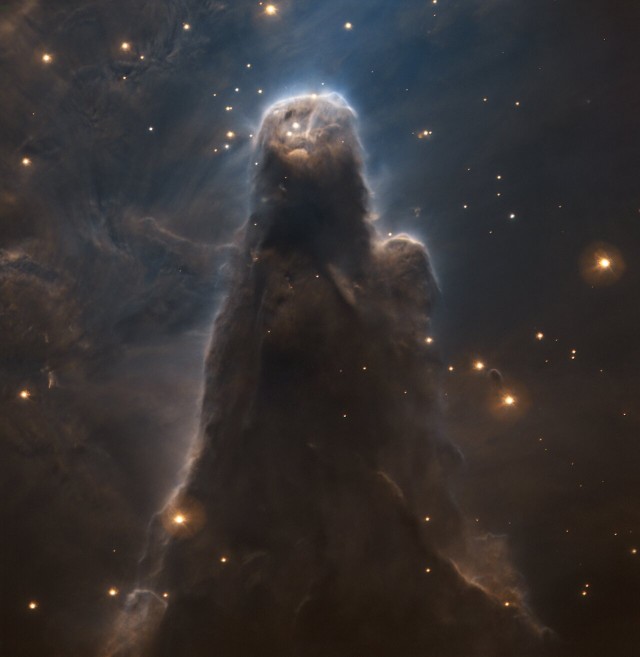Space, the final frontier

- Posts : 41546
Join date : 2012-02-12
Location : wife privilege
- Post n°276
 Re: Space, the final frontier
Re: Space, the final frontier
Једног дана ће та техника толико узнапредовати да ће направити и такав летећи телескоп који ради и без двоструког б у називу. Пајшасамреко.
_____
cousin for roasting the rakija
И кажем себи у сну, еј бре коњу па ти ни немаш озвучење, имаш оне две кутијице око монитора, видећеш кад се пробудиш...

- Posts : 5585
Join date : 2016-01-26
- Post n°277
 Re: Space, the final frontier
Re: Space, the final frontier
Нешто не ради, обуставили су бројање. Мада ово није неко супербитно лансирање.
_____
Burundi is an exception among other nations because it is a country which gave God first place, a God who guards and protects from all misfortune.
Burundi... opskurno udruženje 20ak levičarskih intelektualaca, kojima je fetiš odbrana poniženih i uvredjenih.

- Guest
- Post n°278
 Re: Space, the final frontier
Re: Space, the final frontier
Isaac?паће wrote:Једног дана ће та техника толико узнапредовати да ће направити и такав летећи телескоп који ради и без двоструког б у називу. Пајшасамреко.

- Posts : 52455
Join date : 2017-11-16
- Post n°279
 Re: Space, the final frontier
Re: Space, the final frontier
lalinea wrote:Dzabe, kolonizacija nema alternativu. Otherwise, sitting ducks...Mór Thököly wrote:
Pa otprilike.
Pa da, al znas koliko ima do toga...a do tada je bolje raditi u tisini


- Posts : 52455
Join date : 2017-11-16
- Post n°280
 Re: Space, the final frontier
Re: Space, the final frontier
Mislim, ono - a vidi civilizacija - ma neee, mi ovde samo gajimo paprike i pravimo ajvar, prodjite, nije to voda, to je neko tečno smeće...e, pa aj vidimo se...nekad.

- Posts : 41546
Join date : 2012-02-12
Location : wife privilege
- Post n°281
 Re: Space, the final frontier
Re: Space, the final frontier
Каже се „...паприке па онда однесемо у Грчку да у соби правимо ајвар...“.
_____
cousin for roasting the rakija
И кажем себи у сну, еј бре коњу па ти ни немаш озвучење, имаш оне две кутијице око монитора, видећеш кад се пробудиш...

- Posts : 8095
Join date : 2020-09-07
- Post n°282
 Re: Space, the final frontier
Re: Space, the final frontier
U pravu si. Pobrkao sam šarlatane.
Mór Thököly wrote:Ok, Harari stvarno cesto izgleda tn zvuci kao polusarlatan. Ali kakve veze ro ima sa onim gore?
_____
Sweet and Tender Hooligan

- Posts : 3470
Join date : 2014-10-29
- Post n°283
 Re: Space, the final frontier
Re: Space, the final frontier
Mór Thököly wrote:lalinea wrote:
Dzabe, kolonizacija nema alternativu. Otherwise, sitting ducks...
Pa da, al znas koliko ima do toga...a do tada je bolje raditi u tisini
Mór Thököly wrote:Mislim, ono - a vidi civilizacija - ma neee, mi ovde samo gajimo paprike i pravimo ajvar, prodjite, nije to voda, to je neko tečno smeće...e, pa aj vidimo se...nekad.
Ako cemo ozbiljno na ovu temu (a zanimljiva je tema), tu ima toliko faktora da uopste nije jasno da je takav course of action (ne reklamirati da smo 'napredna' civilazicija) opravdan. Npr, civilizaciji koja je dovoljno razvijena da uopste moze da stigne do nas, ne treba nikakav specijalan input od nas da bi znali da je Zemlja planeta puna vode (ako je bas to ono sto traze).
S druge strane, istina, zaista moze da se zamisli bezbroj SF scenarija gde to sto neko drugi u svemiru zna da smo relativno inteligentna vrsta nije dobra stvar, od neke galakticke imperije kojoj trebaju inteligentni robovi, do neke Q-like egzistencije koja bas ne voli novu emerging inteligence. Ali to su sve projekcije naseg nacina i shvatanja zivota. Mi prosto toliko ne znamo nista, do te mere da gamble prestaje da bude gamble, ako me razumes.
_____
you cannot simply trust a language model when it tells you how it feels

- Posts : 41546
Join date : 2012-02-12
Location : wife privilege
- Post n°284
 Re: Space, the final frontier
Re: Space, the final frontier
Лем је успео (а сад ме уби ако могу да се сетим наслова) да напише тако нешто где се чак догађа контакт, а без контакта, никог не занимају тамо неки Земљани, ни две речи се нису разумели јер разговора напросто није било. Оно пролазак као поред турског гробља, као да ни не постоје.
_____
cousin for roasting the rakija
И кажем себи у сну, еј бре коњу па ти ни немаш озвучење, имаш оне две кутијице око монитора, видећеш кад се пробудиш...

- Posts : 52455
Join date : 2017-11-16
- Post n°285
 Re: Space, the final frontier
Re: Space, the final frontier
lalinea wrote:Mór Thököly wrote:
Pa da, al znas koliko ima do toga...a do tada je bolje raditi u tisini Mór Thököly wrote:Mislim, ono - a vidi civilizacija - ma neee, mi ovde samo gajimo paprike i pravimo ajvar, prodjite, nije to voda, to je neko tečno smeće...e, pa aj vidimo se...nekad.
Mór Thököly wrote:Mislim, ono - a vidi civilizacija - ma neee, mi ovde samo gajimo paprike i pravimo ajvar, prodjite, nije to voda, to je neko tečno smeće...e, pa aj vidimo se...nekad.
Ako cemo ozbiljno na ovu temu (a zanimljiva je tema), tu ima toliko faktora da uopste nije jasno da je takav course of action (ne reklamirati da smo 'napredna' civilazicija) opravdan. Npr, civilizaciji koja je dovoljno razvijena da uopste moze da stigne do nas, ne treba nikakav specijalan input od nas da bi znali da je Zemlja planeta puna vode (ako je bas to ono sto traze).
S druge strane, istina, zaista moze da se zamisli bezbroj SF scenarija gde to sto neko drugi u svemiru zna da smo relativno inteligentna vrsta nije dobra stvar, od neke galakticke imperije kojoj trebaju inteligentni robovi, do neke Q-like egzistencije koja bas ne voli novu emerging inteligence. Ali to su sve projekcije naseg nacina i shvatanja zivota. Mi prosto toliko ne znamo nista, do te mere da gamble prestaje da bude gamble, ako me razumes.
Razumem, naravno. Nego ja mislim da je to prosto sve politika. To sto rade je relativno dzabe, a dobro zvuci. Ima mnogo precih stvari.

- Posts : 6159
Join date : 2014-11-04
- Post n°286
 Re: Space, the final frontier
Re: Space, the final frontier
Podržavam da se sledeći teleskop nazove po Asimovu.Cousin Billy wrote:Isaac?паће wrote:Једног дана ће та техника толико узнапредовати да ће направити и такав летећи телескоп који ради и без двоструког б у називу. Пајшасамреко.
 A oh mislio si verovatno na onog Isaaca iz 17. veka.
A oh mislio si verovatno na onog Isaaca iz 17. veka.
- Posts : 10368
Join date : 2020-06-19
- Post n°287
 Re: Space, the final frontier
Re: Space, the final frontier
Ours in the white space.
_____
Međuopštinski pustolov.
Zli stolar.

- Posts : 35714
Join date : 2012-02-10
- Post n°288
 Re: Space, the final frontier
Re: Space, the final frontier
Eh da je Deretic ziv pa da vidi da su prvi Marsovci Jezerezani a ne Srbi
_____
★
Uprava napolje!

- Posts : 10368
Join date : 2020-06-19
- Post n°289
 Re: Space, the final frontier
Re: Space, the final frontier
ficfiric wrote:Eh da je Deretic ziv pa da vidi da su prvi Marsovci Jezerezani a ne Srbi
Pa jesu Srbi, selo Jezero po kom je krater dobio ime je u RS.
_____
Međuopštinski pustolov.
Zli stolar.

- Posts : 35714
Join date : 2012-02-10
- Post n°290
 Re: Space, the final frontier
Re: Space, the final frontier
E jbg
_____
★
Uprava napolje!

- Posts : 41546
Join date : 2012-02-12
Location : wife privilege
- Post n°291
 Re: Space, the final frontier
Re: Space, the final frontier
fikret selimbašić wrote:ficfiric wrote:Eh da je Deretic ziv pa da vidi da su prvi Marsovci Jezerezani a ne Srbi
Pa jesu Srbi, selo Jezero po kom je krater dobio ime je u RS.
Упоредо са делом наше улице у тамоу је текао неки као поток зван Лондон Бриџ Крик. А онда је на њему био мост, који смо, наравно, звали Лондон Бриџ Крик Бриџ.
_____
cousin for roasting the rakija
И кажем себи у сну, еј бре коњу па ти ни немаш озвучење, имаш оне две кутијице око монитора, видећеш кад се пробудиш...

- Posts : 10368
Join date : 2020-06-19
- Post n°292
 Re: Space, the final frontier
Re: Space, the final frontier
NASA objavila snimku smajli sunca.

Nije me dojmilo ni iznenadilo, znao sam da otprilike ovako zlobno i izgleda kad krene da nas prži kao npr. u julu ove godine.

Nije me dojmilo ni iznenadilo, znao sam da otprilike ovako zlobno i izgleda kad krene da nas prži kao npr. u julu ove godine.
_____
Međuopštinski pustolov.
Zli stolar.

- Posts : 35714
Join date : 2012-02-10
- Post n°293
 Re: Space, the final frontier
Re: Space, the final frontier
Lici na kolegu zlocinca


_____
★
Uprava napolje!

- Guest
- Post n°294
 Re: Space, the final frontier
Re: Space, the final frontier
meni liči na Familijo befikret selimbašić wrote:NASA objavila snimku smajli sunca.
Nije me dojmilo ni iznenadilo, znao sam da otprilike ovako zlobno i izgleda kad krene da nas prži kao npr. u julu ove godine.


- Posts : 8320
Join date : 2014-10-28
Location : imamate of futa djallon
- Post n°295
 Re: Space, the final frontier
Re: Space, the final frontier

_____
i would like to talk here about The Last of Us on HBO... and yeah, yeah i know.. the world is burning but lets just all sit and talk about television. again - what else are we doing with ourselves ? we are not creating any militias. but my god we still have the content. appraising content is the american modus vivendi.. that's why we are here for. to absorb the content and then render some sort of a judgment on content. because there is a buried hope that if enough people have the right opinion about the content - the content will get better which will then flow to our structures and make the world a better place

- Posts : 7165
Join date : 2019-11-04
- Post n°296
 Re: Space, the final frontier
Re: Space, the final frontier
Alien skies
Astronomers can now peer into exoplanet atmospheres like never before, transforming the search for life beyond
Earth. So what’s the plan, asks Stuart Clark
WHEN the first observations from the James Webb Space Telescope (JWST) were made public in July 2022, the images of deep space were so breathtakingly beautiful that it was easy to overlook the dowdy-looking graph released alongside them. The world was agog at the majestic panoramas of clouds of gas and dust from which stars are born, and the shining spiral shapes of ludicrously distant galaxies. Yet for many astronomers, the graph, a simple curving line,
was just as jaw-dropping. It heralded a new era in the search for alien life.
Showing the unambiguous detection of water vapour in the atmosphere of an exoplanet called WASP 96b, it was the first proof that this powerful telescope would be able to deliver what many had doubted, namely, precise details of the contents of atmospheres on worlds beyond our solar system. Just as the beauty of some of those deep-field images captured the imaginations of the public, the quality of this unprecedented graph electrified astronomers. Suddenly, it was clear we really can peer into alien skies like never before. Finally, we have a fighting chance of spotting the subtle signals that would prove life exists elsewhere – not that it will be easy.
Now, astronomers are plotting their next moves. Having whittled down the most promising planets, they are lining
up observing time with JWST to probe their atmospheres, thinking again about what signs of life we should be looking for – and sizing up the prospects of success. “I feel like we’re at the beginning of a really exciting journey,” says Laura Kreidberg at the Max Planck Institute for Astronomy in Heidelberg, Germany.
Exoplanetary atmospheres contain all manner of clues about what the planet is made from. We study them with a technique called spectroscopy, which takes advantage of the fact that different atoms and molecules absorb different wavelengths of light. The first success in probing alien skies came in 2002, when David Charbonneau, then at the
California Institute of Technology, and his colleagues used the Hubble Space Telescope to watch a gas giant world called HD 209458b, nicknamed Osiris, cross the face of its parent star. As it did so, Hubble detected a small dimming of the star’s light at the wavelength absorbed by sodium. The effect disappeared when the planet moved off the face of the star, meaning it must have been caused by sodium in Osiris’s atmosphere.
Alien weather
From then on, astronomers gradually began to dip their toes into analysing exoplanet atmospheres. The initial targets had to be worlds that block an appreciable amount of starlight. These turned out to be the largest and nearest examples of “hot Jupiters”, gas giant planets that sit inexplicably close to their parent star, completing a single orbit in just a couple of Earth days.
For years, astronomers caught glimpses of elements and molecules in the atmospheres of such exoplanets. Then, in 2017, we saw the real power of spectroscopy when it comes to characterising worlds beyond our solar system. Thomas Mikal-Evans, then at the University of Exeter, UK, and his colleagues used Hubble and the infrared Spitzer Space Telescope to study WASP-121b. Watching this hot Jupiter, 850 light years from Earth and about 1.81 times larger than Jupiter, revealed the first water vapour seen in an exoplanet atmosphere.
But they didn’t stop there. After studying WASP-121b for a full orbit, about 31 hours, the team glimpsed something extraordinary. Temperatures on the planet’s dayside, facing the star, were so high that they ripped water molecules apart, producing hydrogen, oxygen and hydroxyl. The heating drove tremendous winds on the planet, sweeping these molecules round to the nightside, where temperatures dropped sufficiently for them to recombine into water. It was the first evidence for weather in another solar system.
“We were actually able to measure this happening by tracking how the spectral feature of water changed from the dayside to the nightside hemisphere,” says Mikal-Evans, now at the Max Planck Institute for Astronomy. The temperature difference was so great, the team speculated, that simple minerals like corundum, a form of aluminium oxide, could also be vaporising on the hot side and condensing into clouds on the cool side.
Corundum forms the basis of rubies and sapphires, meaning the clouds on WASP-121b could be made of ruby and sapphire dust. Until recently, however, the technology enabling spectral analysis of alien skies has had its limits. “With all of the power of Hubble and Spitzer and ground-based telescopes, we’ve only learned a little bit about what to expect for these atmospheres,” says Kreidberg. “We have seen just the very tip of the iceberg.” With the help of JWST, we are now diving below the surface. That is because JWST outstrips its predecessors on three main counts.
First is its position in space. Far from Earth’s orbit, this telescope can keep its targets precisely aligned on its sensors, reinforcing the detection of even faint signals. Second, JWST has a 6.5-metre-diameter mirror, a big step up from Hubble’s 2.4-metre-diameter mirror, which allows JWST to collect a lot more light, revealing fainter details. Perhaps its biggest advantage, though, is that it works across the infrared spectrum. That is a boon because molecules love to interact with light at these wavelengths. “The infrared is the richest spectral region if you want to see absorption by molecules,” says Drake Deming at the University of Maryland. And JWST’s mirror is more than 7.5 times larger in diameter than previous infrared telescopes, like Spitzer.
What all of this means is that, for the first time, astronomers have a real shot at seeing the details of the atmosphere of a rocky exoplanet, which is generally considered the best bet for finding potential signs of life. What we are looking for are smaller rocky planets with atmospheres, like Earth, that happen to orbit within the habitable zone around a star, where temperatures would allow liquid water to exist at the planet’s surface. The trouble is that smaller worlds, with less gravitational heft, can only retain relatively tenuous atmospheres. (For example, Earth’s atmosphere contributes less than 1 per cent to its radius.) So if we want to detect their atmospheres with JWST, these rocky worlds also have to be relatively near.
Those criteria alone hugely narrow the number of viable targets. “For rocky planets that are in the habitable zone and accessible to JWST, we’re talking definitely less than 10,” says Kreidberg.
Even then there are complications. Each of the target planets orbits its own small red dwarf star. These stars are cooler than the sun, so their habitable zones are much closer i than that of the sun, which could make it difficult for the planet to retain an atmosphere. A case in point is the poster child of target systems – TRAPPIST-1, an ultra-cool red dwarf star around 40 light years from Earth with seven known rocky planets. This star’s surface temperature is less than half that of the sun’s, which means its habitable zone is extremely close to the star. So although three or four of the TRAPPIST planets sit in the habitable zone, there is no guarantee that they have atmospheres. “It’s possible that they’re all bare rocks,” says Kreidberg.
Although this particular red dwarf is today cooler than the sun, the situation was reversed during its formation. A star forms when a pocket of interstellar gas contracts under the force of its own gravity. In the process, it releases a torrent of high energy radiation. Smaller stars have weaker gravity and so take longer to contract, meaning that they are releasing this flood of energy for longer than their larger cousins. This could blast away
any atmospheres from nearby planets that are forming.
With all that in mind, Kreidberg will use JWST to observe the TRAPPIST-1 planets as they move in front of and behind their star. The idea is to determine the difference between their day and night temperatures, which will in turn tell her whether each has an atmosphere or not. Atmospheres tend to efficiently distribute heat around a planet, so the day and night temperatures tend to be similar. A bare rock with no atmosphere will heat up on the dayside and then radiate that energy directly into space on the nightside, giving a different temperature profile.
Once we know there is an atmosphere, it will be time to try to get a spectrum and look for the signatures of life. Based on what we know on Earth, the best things to look for are the spectral fingerprints of oxygen and methane. All living things respire; they take in one gas or substance, extract energy from it and then expel a waste gas. In the case of animals, oxygen is the input and carbon dioxide is the output. For plants, it is vice versa.
In animals, metabolising food also produces other waste gases, like methane. All of this builds up in a planet’s atmosphere, knocking it out of chemical equilibrium – and producing a detectable signature. Indeed, the oxygen that we now rely on for life is an excellent example. Earth’s earliest microbes obtained energy via photosynthesis and, like today’s plants, produced oxygen as a waste product. Other microbes evolved to metabolise the oxygen. Seeing oxygen and methane together in an exoplanet atmosphere would be the closest thing to a slam dunk we can currently imagine. These two gases are biologically produced on Earth and otherwise wouldn’t co-exist in the air. Without constant replenishment by living things, they would chemically react and vanish from the atmosphere.
Signs of life
TRAPPIST-1e is the planet that gives the best chance of such a detection. Perfect conditions would raise that chance, but seem unlikely in reality. The list of them is long. “If we’re really, really lucky and the planet has exactly the atmospheric composition we are expecting, JWST performs so perfectly that we can stack up data again and again and again and again to beat down the noise, the atmosphere doesn’t have clouds and there’s no contamination in the spectrum from the host star, which we already know is not true,” says Kreidberg.
“All of those things would have to happen before we could have a prayer of identifying the biosignature.” Put like that, it sounds next to impossible, but such an assessment is based on what we know of life on Earth. “The one thing which would really be delightful is if we saw a biosignature somewhere we didn’t expect,” says Deming, “Everyone’s thinking of rocky planets, like the Earth with solid surfaces and thin atmospheres, but maybe not.” For example, he would love to see something from an exoplanet that resembles Neptune.
Roughly five times the diameter of Earth, and predominantly composed of icy materials, a number of these Neptune-class planets have been discovered around other stars. Intriguingly, some have migrated close enough to their respective stars that they could be covered in global oceans – on the face of it an excellent venue for life. And with larger atmospheres to start with, such hot Neptunes should make JWST’s job easier. When it comes to biosignatures, a new generation of researchers is starting to increasingly think outside the box. Justin Wang at the University of Colorado, Boulder, proposes looking for a set of molecules called polyhydroxyalkanoates (PHAs). These are a family of polyesters made exclusively by microbes. As such, they can be thought of as bioplastics, and wherever they occur, they seem to have some remarkable properties.
“I found many types of microorganisms that use PHA,” says Wang, “and I found that in many of the [microbes known as] extremophiles, the bioplastics are the explanation for how they can survive in those environments.” This is music to the ears of an astrobiologist because extremophiles, as the name suggests, live in harsh environments that most other life on Earth would find toxic. So maybe bioplastics are exactly the kind of molecules that we should be looking for. At present, Wang thinks that such searches are more easily conducted in places like Mars, where robots can scoop up samples of dirt and process it. He can’t easily think of a situation in which PHAs would build up to create a detectable signal in a planet’s atmosphere. Nevertheless, the idea raises the possibility that perhaps we have thought too narrowly so far about the biosignatures we are looking for – or the places to seek them.
As researchers work their way through nearby exoplanets with JWST, we may be in for a very big surprise. The next time NASA and the European Space Agency make a big deal out of a wavy line, it could be because we have answered that big old question: are we alone in the universe? ❚
12 November 2022 | New Scientist

- Posts : 10368
Join date : 2020-06-19
- Post n°297
 Re: Space, the final frontier
Re: Space, the final frontier

Maglina Konus. Omot za death/black metal album se sam napravio.
_____
Međuopštinski pustolov.
Zli stolar.

- Posts : 8095
Join date : 2020-09-07
- Post n°298
 Re: Space, the final frontier
Re: Space, the final frontier
My power’s really low, so this may be the last image I can send. Don’t worry about me though: my time here has been both productive and serene. If I can keep talking to my mission team, I will – but I’ll be signing off here soon. Thanks for staying with me. pic.twitter.com/wkYKww15kQ
— NASA InSight (@NASAInSight) December 19, 2022
_____
Sweet and Tender Hooligan

- Posts : 10368
Join date : 2020-06-19
- Post n°299
 Re: Space, the final frontier
Re: Space, the final frontier
У суботу, 21. јануара 2023. године, млад Месец ће бити тачно 356.568 км од Земље. Према Timeanddate.com, ово је најближи приступ нашој планети од 1030. године.
_____
Međuopštinski pustolov.
Zli stolar.

- Posts : 52455
Join date : 2017-11-16
- Post n°300
 Re: Space, the final frontier
Re: Space, the final frontier

BREAKING:rotating_light:: Scientists Have Just Created a Black Hole in The Lab, And It Has Unexpectedly Started to Glow https://t.co/EVZRRcYnZz
— Amazing Astronomy (@MAstronomers) January 24, 2023



 by паће Wed Jul 13, 2022 11:20 am
by паће Wed Jul 13, 2022 11:20 am
 Јанош Винету
Јанош Винету